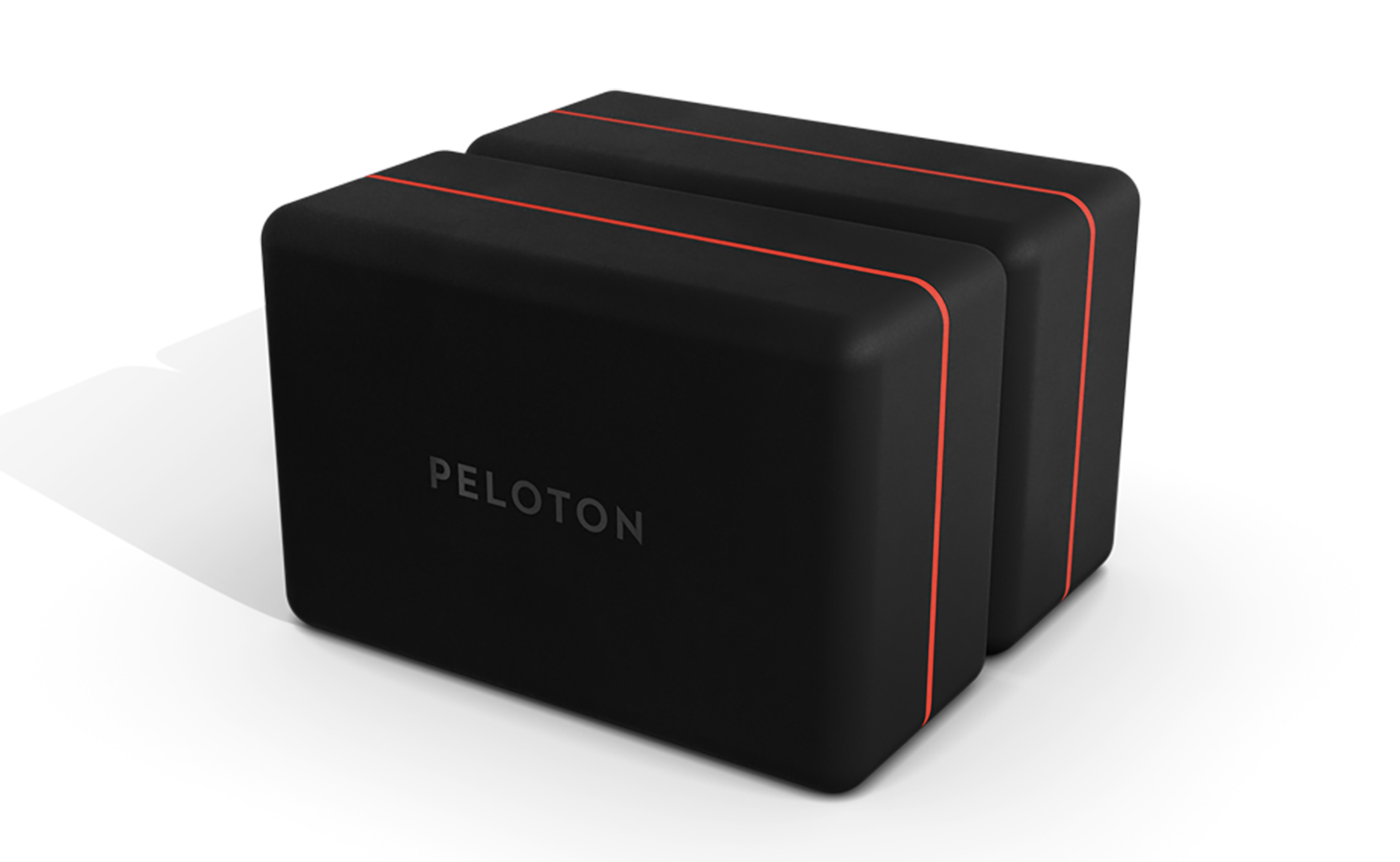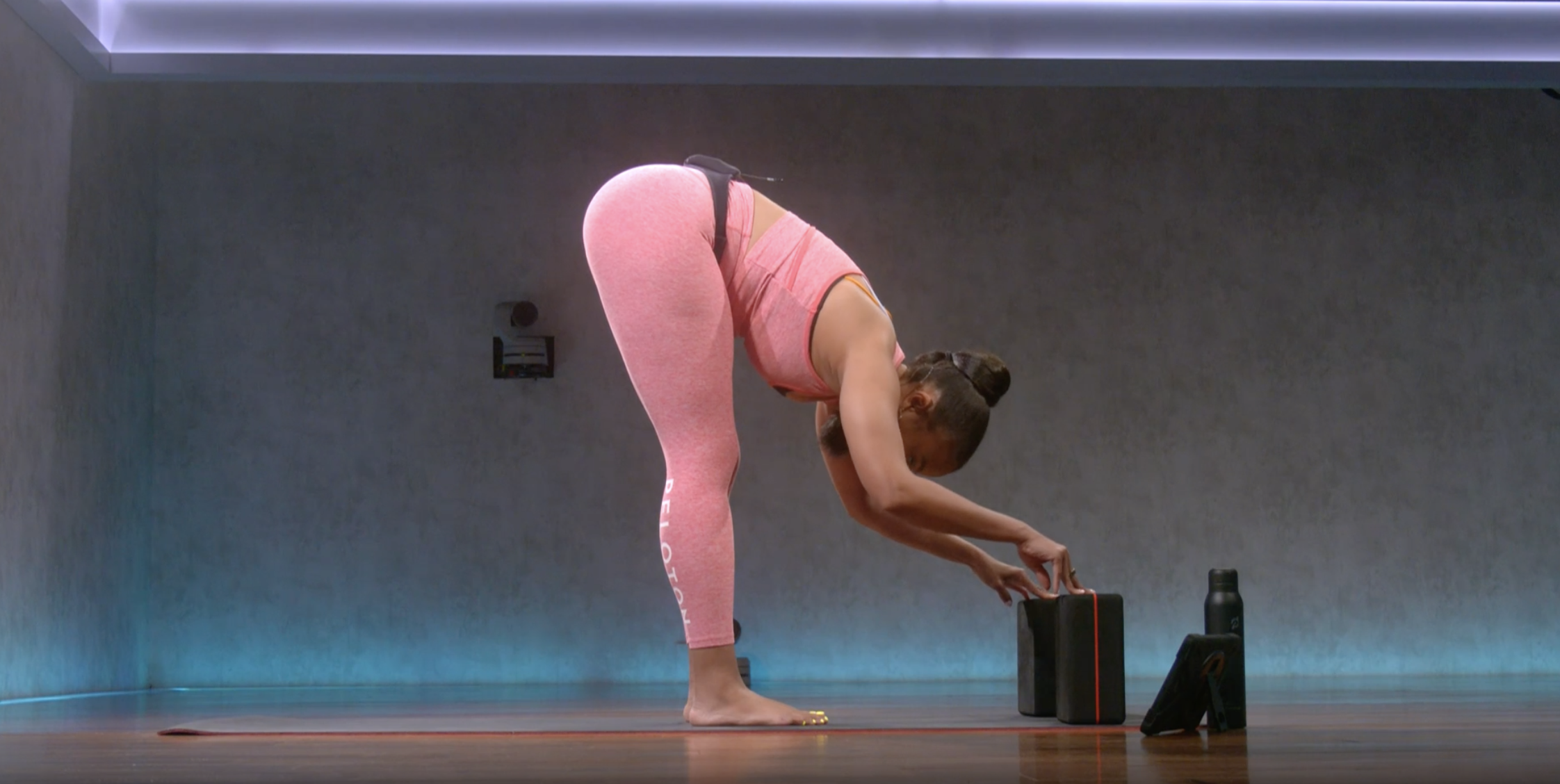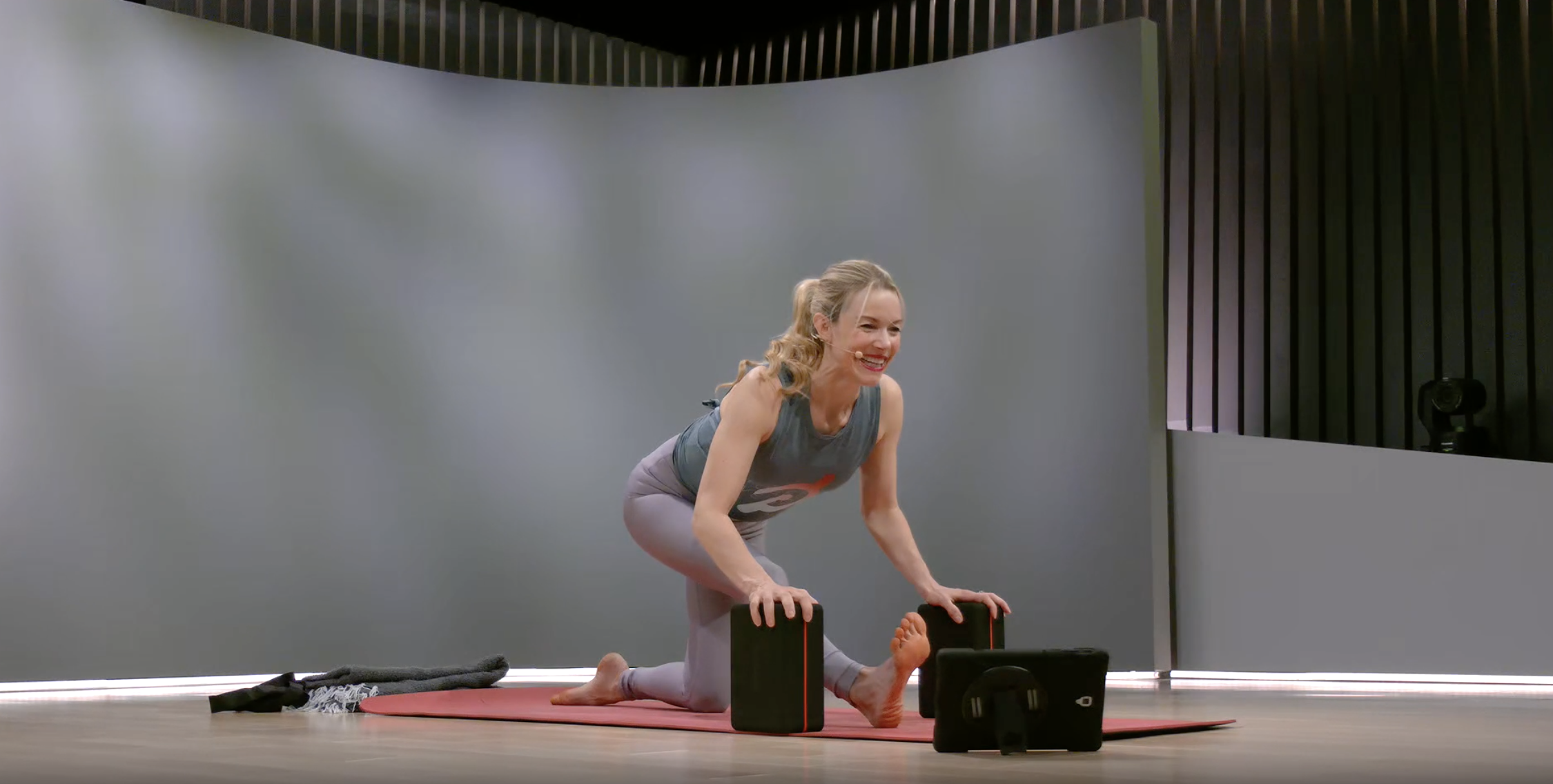
Everything You Need to Know About Using Yoga Blocks In Your Practice
No matter if you're a beginner or more seasoned, anyone can benefit from a little extra support.
By Sarah Klein•
What Are Yoga Blocks?
Why Should You Use Yoga Blocks?
How to Use Yoga Blocks
Yoga Blocks for Beginners
How to Use Yoga Blocks for Beginners
How to Use Yoga Blocks for an Added Challenge
Learn more about how to use yoga blocks and how they can support your yoga practice, with expert advice from Peloton Instructor, Kirra Michel.
Discover more ways to reach your goals with Peloton
Anyone can do yoga, and you can do it just about anywhere, too: All you really need to get started is your body and a comfortable surface to practice on, like a mat or a carpeted floor. But a few additional yoga accessories, like yoga blocks, can make a yoga routine even more accessible and effective.
Yoga blocks—usually rectangular and made of foam or cork—are props or tools (like yoga bolsters, straps, and blankets) that help yogis of all levels deepen their practice. Blocks, also sometimes called yoga bricks, can help people who are new to yoga, those with limited flexibility or mobility, people who are recovering from an injury, or even those looking for a greater challenge.
Keep reading to learn everything you need to know about why you should use yoga blocks, how to pick the right blocks for you, and how to use yoga blocks in a variety of yoga poses—because we can all use a little support sometimes.
What Are Yoga Blocks?
A yoga block is a prop that can enhance your yoga practice. Typically rectangular and made from foam or cork, yoga blocks can:
Help you feel more supported in various poses by having something firm to press against.
Make certain poses more accessible to beginners or people with different body types and abilities by “bringing the ground closer” to you.
Make some movements more challenging when you’re ready to progress by adding resistance.
Why Should You Use Yoga Blocks?
Can’t touch your toes in a standing forward fold? Yoga blocks can help. Can’t comfortably rest your forehead on your mat in a seated forward fold? Yoga blocks can help. You get the picture: It’s almost easier to ask why wouldn’t you use yoga blocks?
Yoga blocks are often thought of as “an extension of the arms,” according to the American Council on Exercise (ACE). Take that standing forward fold, for example: Instead of reaching for your ankles, toes, or mat, you can stand a block by your toes and reach for its highest edge.
“Blocks can create more space in certain postures,” says Peloton Instructor Kirra Michel. “They lift the ground up to you if you can’t reach the ground yet, which allows the posture to be performed with more integrity and without compensating the pose.”
Other reasons to use yoga blocks include:
They can support your back, head, and/or hips.
They improve postural alignment and flexibility.
They make certain poses more accessible to all skill and ability levels.
They can add resistance and challenge to certain poses.
How to Use Yoga Blocks
Typically, you’ll place them on the floor or your mat underneath your hands, feet, back, or forehead or squeeze them between your legs or hands. The exact ways in which you’ll use your yoga blocks will depend on what you want to get out of them. You can use yoga blocks to help support you, add a challenge, and to make yoga poses more accessible. Keep reading for more details on how to use yoga blocks depending on your goals and needs.
How Yoga Blocks Can Act As Support
“Blocks can support the body so the muscles can relax,” Kirra says. As in the standing forward fold example below, if your hamstring flexibility doesn’t allow for you to reach all the way down to the mat, placing your hands on a block in front of you instead gives you more support.
This also allows you to sink deeper into a stretch or posture, she adds. Consider a split: Prop the block up on a short side under your front leg if you’re not ready for a full split on your own. As you grow more comfortable in this position, you can rotate the block to the long side, and eventually remove it entirely.
How to Add Challenge and Develop Strength With Yoga Blocks
Blocks can also be used as a form of resistance to make certain movements harder and build more strength, Kirra says.
For example, you can squeeze a block between your legs while doing postures that tax your core, such as while moving from high to low boat pose “to create more weight as you transition through both postures,” she says.
How to Use Yoga Blocks to Make Yoga Poses More Accessible
Beginners or people with limited mobility or flexibility may find the transitions between poses challenging, Kirra says, and blocks can help.
For example, if you find it tricky to step your foot in between your hands from downward-facing dog to a lunge, you can try placing a yoga block under each hand to give you more space to move your foot and leg through.
Yoga Blocks for Beginners
To really capitalize on those yoga block perks, follow these essential guidelines for picking the right props for your practice.
If possible, consider visiting a sporting goods store to get a feel for a few different shapes, materials, and heights before purchasing your own yoga blocks, according to the Cleveland Clinic. And if you’re not ready to commit to buying blocks but are curious to know if they’d help, you could experiment with similarly sized household items, like rolled-up blankets or sturdy books.
Which Yoga Blocks Are Best for You?
If you’re in the market for a set of blocks for at-home use, a fair amount of the decision ultimately comes down to personal preference, Kirra says, so it’s hard to go wrong.
Standard yoga blocks are rectangular, Kirra says, but you can also find different shapes, including blocks with rounded edges or wedges for support in poses like backbends, as well as different colors to match your personal aesthetic.
Yoga blocks are usually made from foam or cork and come in softer or firmer versions. “I prefer firmer to help with stability and balance,” Kirra says. Cork blocks are usually the more sustainable pick, if that’s important to you. (Cork trees grow so quickly that cork is considered a rapidly renewable material.)
How Many Blocks Should You Use?
Depending on the pose you’re doing and your goal for working with props, you may want one or two blocks, according to the ACE.
You might want two blocks for poses that involve planting both hands on your mat, for example, while one block is plenty if you’re using it for support when balancing on just one arm. If you’re buying blocks to use at home, you’ll probably want to grab a set of two to cover your bases.

Peloton yoga blocks are made from a sturdy EVA foam with rounded corners and edges for easy gripping, and they’re durable and easy to clean: Just wipe them with a few drops of dishwashing soap and a damp towel then air dry.
The Ideal Height for Yoga Blocks
Yoga blocks are usually around 9 inches by 6 inches by 4 inches, Kirra says, but you can also find thicker and thinner options. The perfect height for you will depend on your personal preference (just like with the shape and material of your blocks), as well as what you want to use your blocks for.
You can use yoga blocks at three different heights: Stand a block up on one of its shortest edges to use it at its tallest height. Stand a yoga block on one of its long edges for medium height. And lay the block down flat on one wide side for the lowest height.
How to Use Yoga Blocks for Beginners
Ready to give yoga blocks a try? Kirra suggests starting with the following poses for beginners using yoga blocks.

Standing Forward Fold
Begin standing with two blocks a few inches in front of you at their tallest height.
Bend your knees slightly and hinge at your hips, folding your torso over your legs.
Rest one hand on each block and inhale.
Exhale as you straighten your legs.
Hold for several breaths, then slowly stand up straight.
Why do blocks help? “Forward folds require hamstring flexibility,” Kirra says. “Most of us haven’t spent time working on our hamstring flexibility, so having blocks in front of you and placing your hands on the blocks instead of the floor helps keep the body safe and [maintains] the integrity of the posture without compensating through your spine.”
Warrior 3
Start standing with your torso bent over your legs and your hands on two yoga blocks at their tallest height in front of you.
Reach one leg back and lift it to hip height, flexing your foot.
Hold for several breaths, then return your leg to the starting position.
Repeat with the opposite leg.
Why do blocks help? “It can be difficult learning how to balance in this challenging posture,” Kirra says. “Having blocks in front, under your shoulders, helps keep proper alignment and balance.”

Half Split
Start on your hands and knees with a block at its tallest height under each hand.
Step one leg between your hands, wiggling your heel forward to lengthen and stretch your leg and flex your foot.
Keep your spine long as you hold for several breaths.
Return your leg to the starting position, then repeat with the opposite leg.
Why do blocks help? “Tight hamstrings make this pose [challenging] for many practitioners,” Kirra says. “Without blocks, your shoulders and spine tend to round. Having blocks under your shoulders will allow space in the spine to lengthen and your hamstrings to stretch.”

Supported Bridge
Lie on your back with your knees bent and your feet on the floor or your mat.
Press through your feet to lift your hips.
Slide a block at its lowest height underneath your lower back. Relax your back and glutes into the block.
Hold for several breaths, then remove the block.
Slowly lower your back to the mat one vertebra at a time.
Why do blocks help? “Having a block placed beneath your lower back allows you to soften your muscles and relax into this pose while feeling completely supported,” Kirra says.
How to Use Yoga Blocks for an Added Challenge
More advanced yogis can also use yoga blocks to push their practice further. Kirra offers the following two poses as examples of ways yoga blocks can make poses a little bit harder.
Boat to Low Boat
Start seated with your legs straight in front of you and your hands on the floor behind you. Squeeze a block between your inner thighs.
Lean back slightly and extend your legs so they are about 45 degrees off the floor as you balance on your sit bones and tailbone.
Keeping your back straight, stretch your arms out parallel to the floor.
Hold this position for a few breaths.
Lower your arms so your low and mid back are on your mat.
Lower your legs so they are just a few inches off the ground.
Hold this position for a few breaths, then relax. Or, you can return to boat pose and continue alternating between the two for even more ab work.
Why do blocks help? The block “creates more ‘weight’ as you transition through both postures,” Kirra says, because you’ll be squeezing your thighs the entire time to make sure it stays in place and doesn’t drop to the floor.
Seated Forward Fold
Start sitting with your legs straight in front of you and a block in front of your feet at its lowest height.
Inhale and sit up tall, extending your arms over your head.
Exhale as you lean forward, reaching for your ankles or toes.
Gently walk your hands to the block.
Hold for several breaths, lengthening your spine on each exhale, then slowly sit up.
Why do blocks help? “Reaching your hands to the block allows a deeper stretch,” Kirra says.
Knowing when and how to best use yoga blocks depends a lot on listening to your body. Tune into those cues that you need more support in a certain position or signs you’re ready for more of a challenge. You can get even more guidance by exploring the yoga classes available on the Peloton App.

Peloton App
Access thousands of classes with no equipment needed.
This content is for informational and educational purposes only and does not constitute individualized advice. It is not intended to replace professional medical evaluation, diagnosis, or treatment. Seek the advice of your physician for questions you may have regarding your health or a medical condition. If you are having a medical emergency, call your physician or 911 immediately.
Level up your inbox.
Subscribe for a weekly dose of fitness, plus the latest promos, launches, and events.
By providing your email address, you agree to receive marketing communications from Peloton.
For more about how we use your information, see our Privacy Policy.











